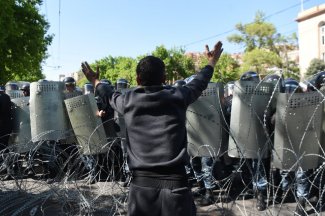Chancellor-style governance model in Armenia

On 17 April, the parliament of Armenia elected Serzh Sargsyan (alternatively transliterated as Sarkisyan) prime minister, having previously served as president. This marked the end of the period of transition from the presidential to the parliamentary system initiated by the constitutional referendum in 2015. The new president is Armen Sargsyan (the two politicians are not related), who took office on 9 April. He was elected by the parliament for a single seven-year term (previously presidents were elected in general elections for five-year terms, with a possibility of being re-elected once). The nomination of the former president for the head of government sparked a massive wave of protests against Serzh Sargsyan run by politicians from the Way Out (Yelk) parliamentary alliance.
Commentary
- Serzh Sargsyan has managed to keep power in his hands, even though he will exercise it on different terms, and the main beneficiary of the changes will be the elite concentrated in the governing Republican Party of Armenia who have strengthened their dominant position in the country. As part of the new solution, the prime minister, who has taken over most of the previous presidential prerogatives, is in fact the head of state – he is the chairman of the Security Council, he holds the right of pardon, and at wartime becomes the commander in chief of the armed forces (given the conflict with Azerbaijan over Nagorno-Karabakh, this option is not merely theoretical; Serzh Sargsyan also served as Armenia’s minister of defence for many years in the past). The role of the president, who cannot belong to any party, has been limited to performing representation functions, formally approving government members and signing acts adopted by the parliament.
- President Armen Sargsyan, who initially embarked on a career in science (precisely physics – he used to teach at the University of Cambridge amongst other universities), joined the diplomatic corps after the collapse of the USSR. For example, he served three times as Armenia’s ambassador to the United Kingdom. He also served as the country’s prime minister for a few months in the mid 1990s. In 2000–2013, he was engaged in business. The fact that he is well-travelled and has extensive contacts in both Western countries (including with the British Royal Family) and the CIS, backed with his financial independence, all suggest that his tasks will most likely be to lobby for Armenian interests in the international arena (including regarding Armenia’s relations with Turkey and the conflict over Nagorno-Karabakh) and taking action to diversify Yerevan’s foreign policy where asymmetric relations with Russia have so far been predominant. In the area of the economy, this lobbying will be focused on attracting foreign investments to Armenia. It cannot be ruled out that, following the prime minister’s instructions, Armen Sargsyan will be entrusted with informal tasks during his visits in the West.
- The street protests against Serzh Sargsyan have been taking place under the patronage of the pro-European Way Out Alliance, which is the only real opposition force in the parliament (holding 9 out of 105 seats in the National Assembly). Thousands of people have taken to the streets. Attempts were made to block government buildings during the demonstrations. All this has revealed a high degree of public frustration resulting from financial difficulties and the lack of prospects in a situation where the power of the present political and oligarchic system is becoming entrenched. Apart from in the capital, the protests have been seen in a number of other cities; they have shown that the government should expect increasing public dissatisfaction, and that the Armenian public, capable of mobilisation, is an important factor on the political scene.


